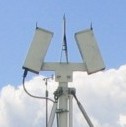Precipitation Occurrence Sensor System (POSS)

The Andrew Antenna POSS is a small, low power, continuous wave, bistatic system that uses an X-band Doppler radar (Sheppard 1990). The transmitter and receiver are housed separately mounted on a frame 45 cm apart (see photo at right). The sensor measures the Doppler signal of particles falling through a small measurement volume (of the order of a cubic meter depending on particle size) extending to a maximum range of about 2 m above the sensor. From this, a Doppler power density spectrum is computed and the occurrence, type, and rate of precipitation are estimated. The POSS does not estimate obstruction to vision or visibility.
In addition, a multiparameter algorithm that uses the POSS output, the dewpoint and the output from a Rosemount icing detector, Model 872E; (Wilson and Van Cauwenberghe 1993) is used to estimate a precipitation type. These additional sensors were part of the sensor suite at the test site. The primary reason for including these results is to evaluate the performance of the multiparameter algorithm compared to the stand-alone POSS output.
Sheppard, B. E., 1990: The measurement of raindrop size distributions using a small Doppler radar. J. Atmos. Oceanic Technol., 7, 255-268.
Wilson, R. A., and R. Van Cauwenberghe, 1993: Intercomparison results of two types of freezing rain sensors versus human observers. Tech. Conf. on Instruments and Methods of Observation, Vienna, Austria, WMO/TD-No. 462, 167-170.